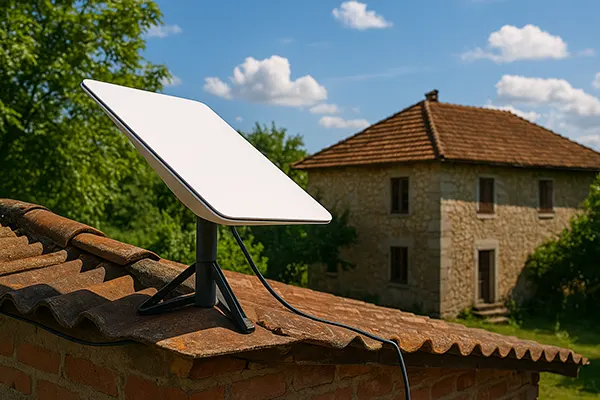Starlink in Germany: A Viable Alternative to DSL and 5G in Rural Areas?

While most urban regions in Germany benefit from stable broadband or 5G connections, vast areas of rural countryside continue to suffer from limited access to high-speed internet. This digital divide poses a challenge to remote workers, students, and businesses. As of February 2025, the spotlight is turning to Starlink – the satellite internet service by SpaceX – as a potentially transformative solution. But can it genuinely serve as a dependable replacement for traditional DSL and modern 5G networks?
Current State of Internet Infrastructure in Rural Germany
Germany’s rural internet infrastructure has long been plagued by slow speeds and unreliable service. Despite numerous government initiatives to expand broadband coverage, many regions still rely on outdated DSL technology, offering speeds below 10 Mbps. In contrast, urban centres enjoy gigabit connections through fibre-optics or advanced mobile networks.
5G rollouts have begun to bridge this gap, but deployment remains focused on high-density areas. Rural zones often lack the necessary tower density, making consistent 5G access patchy or entirely unavailable. The result is a persistent inequality that hampers digital inclusion.
Given this context, the appeal of satellite-based internet is evident. It does not depend on terrestrial cables or nearby towers, offering the potential to bring internet access to even the most isolated homesteads and villages.
Why Starlink Is Gaining Attention
Starlink’s core advantage lies in its low-Earth orbit (LEO) satellite network, which significantly reduces latency compared to traditional geostationary systems. With latency between 20–40 ms and download speeds ranging from 50 to 250 Mbps, it’s well-suited for video calls, streaming, and online work – even in remote areas.
Installation is relatively straightforward: a user receives a satellite dish, Wi-Fi router, and app-guided setup instructions. Within minutes, internet access is available without the need for technicians or cables. This ease of use is particularly valuable in rural communities where infrastructure work is slow or non-existent.
Additionally, Starlink is currently expanding coverage across Germany, with improvements in speed and consistency as more satellites are launched. As of early 2025, it is available in nearly all federal states, including Bavaria, Thuringia, and Saxony – all known for their extensive rural landscapes.
Cost, Equipment, and Accessibility in 2025
Affordability is a key consideration for rural users. Starlink’s pricing in Germany as of February 2025 stands at approximately €65 per month, with a one-time hardware cost of around €300. While higher than basic DSL, it competes well with mobile internet subscriptions offering similar speeds.
The hardware includes the Starlink dish, router, and mounting tools. Power requirements are modest, with total consumption averaging 50–70W, making it suitable even for homes with limited energy infrastructure. There are also now third-party mounting kits for users in mountainous or forested terrain, making installation more flexible.
Starlink has also introduced a flexible roaming option, allowing users to take their dish to a different location – ideal for seasonal workers, campers, or those with second homes in rural areas. This mobility is not possible with DSL or fixed-location 5G routers.
Comparison with DSL and 5G
When compared to DSL, Starlink offers a dramatic improvement in speed and reliability. DSL connections in rural Germany often deliver less than 16 Mbps with significant latency, making them unsuitable for modern demands such as remote work or online education.
Against 5G, the picture is more nuanced. Where 5G is available, it can outperform Starlink in terms of speed – sometimes exceeding 500 Mbps – and does not require sky visibility. However, coverage gaps and terrain limitations still render it ineffective in many rural regions.
Starlink fills this void by ensuring consistent service regardless of topography or tower proximity. The trade-off in absolute speed is offset by its availability and ease of setup, which are crucial factors for many users in isolated communities.

Regulatory and Future Outlook
The German Federal Network Agency (Bundesnetzagentur) has so far been supportive of satellite internet initiatives, including Starlink. Licences and spectrum allocations have been granted with minimal bureaucracy, and further integration with national broadband strategies is underway.
Looking ahead, SpaceX plans to enhance Starlink through laser inter-satellite links, improving data routing and reducing reliance on ground stations. This could lead to lower latency and better throughput even in adverse weather conditions, a common issue in Germany’s mountainous regions.
In parallel, local competition is emerging. Providers like OneWeb and Amazon’s Project Kuiper are aiming to enter the German market in late 2025, which could drive innovation and reduce prices. However, as of now, Starlink maintains a clear lead in deployment and performance.
Is Starlink a Practical Long-Term Solution?
For households and small businesses in remote parts of Germany, Starlink offers an immediate and practical way to access high-speed internet. The setup is manageable, the performance is solid, and the coverage is unmatched in sparsely populated areas.
However, for those in regions on the edge of urban connectivity or with partial 5G coverage, a hybrid approach might be more cost-effective. Starlink’s flat monthly rate makes it less attractive where fibre or mobile data packages are competitively priced.
Overall, Starlink is not a one-size-fits-all solution, but it has earned its place as a legitimate alternative. As the network evolves and competition heats up, rural internet access in Germany may finally catch up with urban standards – and Starlink is leading that charge in 2025.
